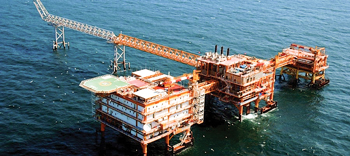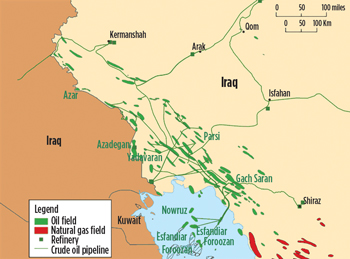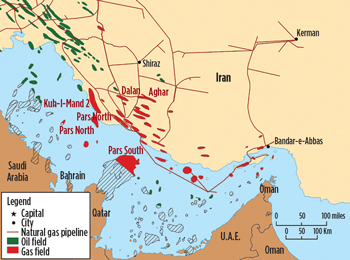IAN LEWIS, Contributing Editor
 |
| Iranian offshore platform complex at South Pars (photo courtesy of Pars Oil and Gas Company). |
|
Continuing U.S.-led sanctions against Iran, imposed in a bid to stem the country’s nuclear program, are taking their toll on the nation’s oil and gas sector. Oil production has fallen, and local firms are struggling to acquire the equipment, from foreign countries, that they need to push ahead with hydrocarbon projects.
While the Iranian government says oil production is running at around 3.7 MMbpd, regional observers say the figure is likely to be considerably less, at around 2.7 MMbpd (Editor’s note: World Oil carried a 2012 production figure of 3.45 MMbpd for Iran in its annual worldwide activity tables, in the September 2013 issue). A U.S. government official, quoted by Bloomberg, said in August that Iran’s crude oil revenues had fallen 58%, to $3.4 billion, in first-half 2013, compared to $6.3 billion in the same period of the previous year.
Petroleum Minister Bijan Namdar-Zanganeh, who was appointed after the election of Iran’s new president, Hassan Rohani, in August, has said that he plans to boost production to the previous level of 4.2 MMbopd.
Zanganeh was also energy minister previously, having been removed in 2005 following the election of former President Mahmoud Ahmadinejad. He is regarded by many Iran-watchers as a highly-experienced, and competent, minister.
“The new oil minister has experience, not only in oil and gas, but also in the power sector. He understands the technical and commercial issues. In my view, he is one of the best ministers Iran has had since the Iranian revolution in 1979,” says Siamak Adibi, head of the Middle East gas team at consultancy Facts Global Energy (FGE), who formerly worked at the National Iranian Gas Export Company.
Zanganeh told Iranian news agency Fars, on taking office, that “revival of Iran’s lost oil markets is among my top priorities”, suggesting that fellow OPEC members should either cut their output, to make room for new Iranian production, or accept that oil prices would decline. However, Iran’s ability to achieve such an ambitious objective in the current climate is far from assured.
“The problem is that, even with a strong team, it will be difficult to achieve radical change, due to the issues affecting the Iranian political system and sanctions. If sanctions were eased, so that Iran could sell more oil and ramp up production, that would be a different story. But it all depends on the political side and solving the nuclear issue,” Adibi says.
Sanctions have not only targeted oil sales, but also foreign investment in the hydrocarbon industry, as well as imports and financing, related to oil and gas projects. Foreign firms have largely left the sector, leaving domestic companies to fill the gap.
While domestic firms may have the experience, and capacity, to build hydrocarbon infrastructure, the impact of sanctions means they cannot easily obtain rigs, wellhead equipment, pipeline components, and so on.
| Table 2. Drilling rigs operating in the deepwater Gulf of Mexico. Source: BSEE, March 2013 |
|

|
“All projects are facing long delays, because local firms cannot easily get hold of equipment,” says Adibi.
Finding the oil to export may also prove problematic. Iran’s gas reserves are either the world’s largest or second-largest, depending on how Russia’s reserves are calculated, and have plenty of long-term potential; however, oil presents a different story.
Even if all sanctions were removed from the hydrocarbon sector, declines in production from existing oil fields would limit any rise in output. FGE estimates that the cap would be around 3.5 MMbopd, given existing resources, although enhanced recovery techniques could yield more, if the technology was available. That picture would change, if new oil reserves were discovered, but while drillers are announcing fresh gas finds on a regular basis, oil strikes have proved a lot more elusive.
GAS PUSH
Iran has, so far, failed to capitalize fully on its location atop gas reserves of more than 1,196 Tcf, or 17% of the world total, according to figures from World Oil’s annual worldwide activity tables in the September 2013 issue. As with oil developments, planned expansion of gas production is likely to be hit hard by the effects of sanctions in the short term. Many of Iran’s gas reserves, as well as oil deposits, are in fields shared with the country’s neighbors, further complicating some developments.
Annual gas production was estimated at 5.65 Tcf (15.5 Bcfd) in 2012, with most of that serving the growing domestic power, residential and commercial markets. This contrasts with the dominant position in the global LNG export market of Qatar, Iran’s tiny neighbor across the Persian Gulf, with which it shares the giant South Pars offshore field.
There are signs that Iran is keen to play catch-up with Qatar. Previous Minister of Petroleum Rostam Qasemi said in 2012 that the country wanted to more than double its total gas production by 2015. At present, gas exports, via pipeline, to some of Iran’s neighbors are negligible; however, this could start to change, if a plan to export gas to Oman is realized.
The two countries signed a memorandum of understanding in August that could lead to the construction of a pipeline across the Gulf of Oman. This would provide a supply of feedstock for Oman’s under-used LNG capacity from Iran’s Kish field, which has gas reserves in-place, estimated at more than 70 Tcf. However, analysts note that with development of Kish field a long way behind schedule, the first gas from such a project would be unlikely to materialize for another six or seven years.
OIL E&P DEVELOPMENTS
 |
| Fig. 1. Iran’s largest oil fields (image courtesy of EIA). |
|
Iran is estimated to hold proved oil reserves of 154.6 billion bbl, more than 9% of the world total, according to recent figures (World Oil, September 2013). Iran’s largest producing field is Ahvaz, located close to the south end of the country’s border with Iraq. The Asmari, Bangestan and Mansouri areas that comprise the field are estimated to have a combined production capacity of around 750,000 bopd. Abuzar is the country’s largest offshore field, with a production capacity of 175,000 bopd. NIOC has a long-standing commitment to boost Abuzar’s capacity to 220,000 bopd.
In terms of potential new oilfield development, much attention will be focused on the North and South Azadegan fields, in the west of the country, which hold Iran’s largest oil reserves. They are estimated to contain some 26 billion bbl of proven reserves between them, with recoverable resources initially estimated at around 6 billion bbl.
They form part of a larger oil-bearing formation, which extends into southern Iraq. The fields on the Iraqi side of the border have been attracting significant volumes of oil company investment recently. Since their discovery in 1999, the development of Iran’s reserves, here, has been hampered by difficult geology, as well as by international sanctions.
Japan’s INPEX had been developing South Azadegan field, after signing an agreement in 2004, but the firm pulled out in 2010, due to the potential harm from U.S. sanctions on its global developments. Production, from existing developments on the field, was estimated to be some 50,000 bopd in 2012. Development of these fields is still continuing, albeit years behind the originally envisaged schedule.
In July, Rostam Qasemi, petroleum minister in the last government, said Chinese firms had agreed to invest $20 billion in developing both North and South Azadegan oil fields, as well as the nearby Yadavaran oil field, which is estimated to hold around 3.2 billion bbl of proved reserves. He said 20 drilling rigs were already in place across the fields, and that they would produce 700,000 bopd, when fully operational. Of that, some 260,000 bopd will come from South Azadegan and 150,000 bopd from North Azadegan. Qasemi said Yadavaran would produce 300,000 bopd, when the project was complete.
The Azadegan fields are being developed in two phases, with the first scheduled to be complete in 2016 and the second in around 2020, though analysts say the country’s difficult economic conditions may cause slippage in the timetable. China National Petroleum Corp. (CNPC) is carrying out the phase one development of the Azadegan fields, while Sinopec has been developing Yadavaran, since it signed a contract with NIOC in 2007.
Progress in developing other oil reserves has also suffered, due to the effects of sanctions and other issues, which have prompted proposed partners to pull out over recent years. Potentially the most promising is the Iranian side of Azar field, which straddles the Iran-Iraq border, and has proved reserves of around 2.5 billion bbl. However, progress stalled, when Iran dropped Gazprom from a plan to develop the field in 2011. The government cited a failure by the Russian energy firm to meet its commitments to the project, but did not elaborate. The Iranian petroleum ministry, via the state-owned Oil Industries Engineering and Construction Company (OIEC), then signed a $2-billion contract, in late 2011, to develop the field with a consortium of domestic firms. These include Persia Oil And Gas Company, and the National Iranian Drilling Company (NIDC).
The consortium’s first well on the field, Persia-1, was drilled in October 2012, as part of plans to drill around 20 wells in total. The developers have said that the project could be complete in 4-5 years, adding some 65,000 bopd to Iranian output. However, it remains unclear, whether this target can be met in current economic conditions.
GAS E&P DEVELOPMENTS
 |
| Fig. 2. Iran’s major gas fields (image courtesy of EIA). |
|
South Pars, the largest known gas field in the world, covers some 3,700 sq mi, of which around 1,400 sq mi are in Iranian waters. Qatar possesses the rest, including the prolific North Dome. The field, which was discovered in 1990, is being developed by Iran in a 29-phase project. The first ten phases were slated for domestic consumption, with later phases slated for export markets via pipeline, LNG plants and gas-to-liquids facilities.
However, the pace of development has been severely slowed by the effects of sanctions, which have triggered the withdrawal of key players, such as Total, Petronas, Schlumberger and others. New petroleum minister Zanganeh has said that he wants the South Pars gas development finished as quickly as possible.
Chinese investment, while evident in the oil sector, has not been as forthcoming in gas projects. CNPC is believed to have pulled out of its planned involvement in phase 11 last year, due to Iranian governmental accusations that the company was to blame for delays in starting work on the project.
In August 2013, NIOC signed an agreement, worth $5 billion, with Iranian firm Petropars to complete phase 11 of South Pars, replacing CNPC, said Iranian state media. Petropars has managed several of the existing, much-delayed, phases of the projects and has already been awarded contracts for future phases 12 and 19.
Under the phase 11 contract, Petropars will install two wellhead platforms, drill 12 wells and build two 135-km pipelines to transfer gas onshore. This phase is intended to produce 70.63 Bcfd of sour gas and 80,000 MMtpa of gas condensate, serving a planned onshore LNG export facility, according to local media reports.
In December 2011, Iran’s petroleum ministry said that an oil and gas field had been discovered in the Caspian Sea, with estimated reserves of 2 billion bbl of light crude and 50 Tcf of natural gas, at a water depth of around 2,300 ft. International observers have, so far, been cautious over accepting Iranian claims about the potential of the field, known as Sardar-e-Jangal. Iran claims that the field lies entirely within its territorial waters. However, given the discovery’s proximity to international maritime borders, it is possible that the field may be shared with Azerbaijan or Turkmenistan. Disputes could flare up over the precise locations of these borders, some of which are ill-defined, potentially slowing development.
The discovery of Khayyam field, in the Persian Gulf, off Hormuzgan Province in the south of the country, was announced in early 2010. At that point, it was thought to be predominantly a gas field, with estimated reserves of 9.18 Tcf of gas, of which 7.42 Tcf were recoverable. Later in 2011, Iran said the field also contained a light oil deposit, with estimated in-place reserves of 756 MMbbl, of which around 170 MMbbl were recoverable.
Development of Forouz B field, also in the Persian Gulf, is reported to be underway. The field, which holds estimated in-place gas reserves of 29 Tcf, plus 180 MMbbl of gas condensates, is scheduled to supply a proposed petrochemical complex on nearby Lavan Island, and a 3-gigawatt power station. In February 2013, Iranian media reported that a development contract for Forouz B was signed between National Iranian Offshore Oil Company (NIOOC) and the local Mapna Group. The project is slated to take five years to build.
Production sharing in hydrocarbon sector
If recent media reports turn out to be correct, that Iran has been in talks with an Indian consortium over a possible production sharing agreement (PSA) for a gas field investment, it would mark a significant shift in policy for the Iranian government, which has rejected the model, thus far.
Currently, the constitution permits only state ownership of oil and gas resources, principally through the National Iranian Oil Corporation (NIOC). Rather than signing PSAs, the government does business with a foreign oil company via buyback contracts, which enable the firm to become operator of projects via a locally established affiliate.
The terms usually allow the foreign firm to take a set amount of oil or gas from a project, in return for its capital injection and services. When the project is complete, field operatorship returns to the state entity involved.
The rate of return on buyback contracts lies in the 12%-17% range, with payback over five to seven years, according to FGE. 
|
Production sharing in hydrocarbon sector
If recent media reports turn out to be correct, that Iran has been in talks with an Indian consortium over a possible production sharing agreement (PSA) for a gas field investment, it would mark a significant shift in policy for the Iranian government, which has rejected the model, thus far.
Currently, the constitution permits only state ownership of oil and gas resources, principally through the National Iranian Oil Corporation (NIOC). Rather than signing PSAs, the government does business with a foreign oil company via buyback contracts, which enable the firm to become operator of projects via a locally established affiliate.
The terms usually allow the foreign firm to take a set amount of oil or gas from a project, in return for its capital injection and services. When the project is complete, field operatorship returns to the state entity involved.
The rate of return on buyback contracts lies in the 12%-17% range, with payback over five to seven years, according to FGE.

|
|






